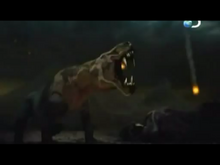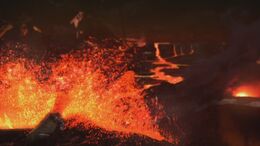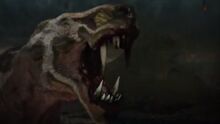(Gorgonopsid were mammal relatives, not birds.) |
(Adding categories) |
||
| (6 intermediate revisions by 6 users not shown) | |||
| Line 14: | Line 14: | ||
== Physical Characteristics == |
== Physical Characteristics == |
||
| − | ''Inostrancevia '' was a type of gorgonopsid. Gorgonopsids belong to a group of |
+ | ''Inostrancevia '' was a type of gorgonopsid. Gorgonopsids belong to a group of amniotes related to mammals known as "therapsids". Like extant mammals, inostrancevia was likely warm-blooded and covered in fur, with limbs that were almost fully erect in posture and heterodont dentition. However, inostrancevia differed from modern mammals because it still had very primitive jawbones, laid eggs and couldn't lactate. Inostrancevia was an apex predator. This animal hunted big game using their large sabre teeth. These teeth are remarkably similar to those of the more recent group of animals called a "sabre-toothed tiger". These teeth were most likely used to puncture its prey's trachea. Unlike modern carnivorous mammals, Inostrancevia lacked molars and carnassials, and had to swallow bits of meat whole. |
| + | [[File:Latest.png|thumb|220x220px|''Inostrancevia'' roaring to defend his meal.]]''Inostrancevia'' measured 3.5 metres (11.5 ft) in length. This easily makes it the largest gorgonopsid (discounting birds as only a few fragments of this animals have been discovered). |
||
| − | ==In |
+ | ==In dinosaur revolution== |
[[File:DR1x1_Inostrancevia_44.jpg|thumb|left|260px|An Inostrancevia being incinerated by a lava flow. (''[[Evolution's Winners]]'')]] |
[[File:DR1x1_Inostrancevia_44.jpg|thumb|left|260px|An Inostrancevia being incinerated by a lava flow. (''[[Evolution's Winners]]'')]] |
||
===''[[Evolution's Winners]]''=== |
===''[[Evolution's Winners]]''=== |
||
| − | An ''Inostrancevia'' was walking in the barren, light, Permian landscape, almost stepping on a cockroach. Giant parts of molten rock were being thrown in the background. He walked to another |
+ | An ''Inostrancevia'' was walking in the barren, light, Permian landscape, almost stepping on a cockroach. Giant parts of molten rock were being thrown in the background. He walked to another ''Inostrancevia'', only to find that it was dead. Furthermore, a third ''Inostrancevia'' was feeding on the second one, hinting that the apocalypse has begun and that little food was around, so they resorted to cannibalism. |
[[File:DR Inostrancevia.jpg|thumb|220x220px|''Inostrancevia'' roaring.]] |
[[File:DR Inostrancevia.jpg|thumb|220x220px|''Inostrancevia'' roaring.]] |
||
| − | They roared at each other, threatening over food, until a rock hits the carcass and run away, but the cannibal ''Inostrancevia'' hit by |
+ | They roared at each other, threatening over food, until a rock hits the carcass and they both run away, but the cannibal ''Inostrancevia'' is hit by another rock, and is killed by it. The hungry ''Inostrancevia'' survives and leaps onto a big rock before the ground breaks apart and lava bubbles up. It goes to the edge of the cliff, and rests, roaring and watching as its own world came to an end. |
| + | |||
==Gallery== |
==Gallery== |
||
<gallery widths="120" columns="5" spacing="small"> |
<gallery widths="120" columns="5" spacing="small"> |
||
| Line 35: | Line 37: | ||
[[Category:Non dinosaurs]] |
[[Category:Non dinosaurs]] |
||
[[Category:Evolution's Winners animals]] |
[[Category:Evolution's Winners animals]] |
||
| + | [[Category:Creatures]] |
||
| + | [[Category:Prehistoric Creatures described in 1922]] |
||
Revision as of 00:53, 4 July 2020

| |
| Creature information | |
| Scientific name : | Inostrancevia alexandri |
| Time period : | Late Permian period |
| Primary diet : | Carnivore |
| In the series | |
| Appearances : | Evolution's Winners |
Inostrancevia was a genus of gorgonopsid which lived during the late Permian period before the devastating mass extinction preceding the beginning of the Triassic period.
Physical Characteristics
Inostrancevia was a type of gorgonopsid. Gorgonopsids belong to a group of amniotes related to mammals known as "therapsids". Like extant mammals, inostrancevia was likely warm-blooded and covered in fur, with limbs that were almost fully erect in posture and heterodont dentition. However, inostrancevia differed from modern mammals because it still had very primitive jawbones, laid eggs and couldn't lactate. Inostrancevia was an apex predator. This animal hunted big game using their large sabre teeth. These teeth are remarkably similar to those of the more recent group of animals called a "sabre-toothed tiger". These teeth were most likely used to puncture its prey's trachea. Unlike modern carnivorous mammals, Inostrancevia lacked molars and carnassials, and had to swallow bits of meat whole.

Inostrancevia roaring to defend his meal.
Inostrancevia measured 3.5 metres (11.5 ft) in length. This easily makes it the largest gorgonopsid (discounting birds as only a few fragments of this animals have been discovered).
In dinosaur revolution

An Inostrancevia being incinerated by a lava flow. (Evolution's Winners)
Evolution's Winners
An Inostrancevia was walking in the barren, light, Permian landscape, almost stepping on a cockroach. Giant parts of molten rock were being thrown in the background. He walked to another Inostrancevia, only to find that it was dead. Furthermore, a third Inostrancevia was feeding on the second one, hinting that the apocalypse has begun and that little food was around, so they resorted to cannibalism.

Inostrancevia roaring.
They roared at each other, threatening over food, until a rock hits the carcass and they both run away, but the cannibal Inostrancevia is hit by another rock, and is killed by it. The hungry Inostrancevia survives and leaps onto a big rock before the ground breaks apart and lava bubbles up. It goes to the edge of the cliff, and rests, roaring and watching as its own world came to an end.





